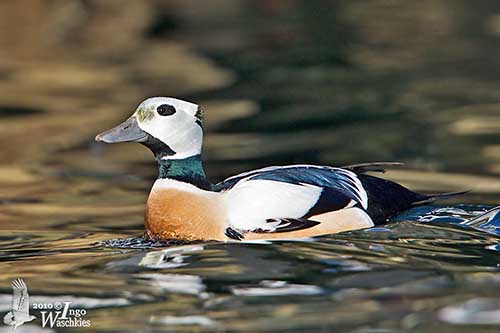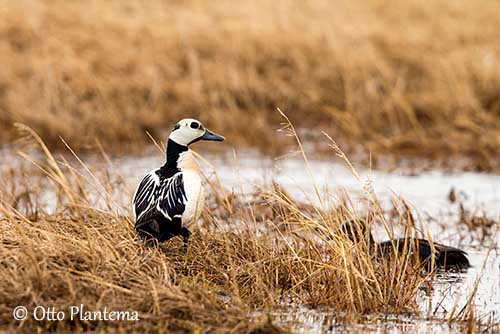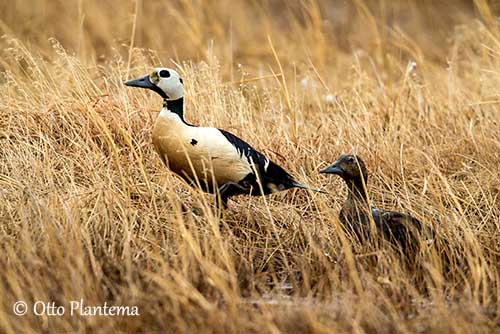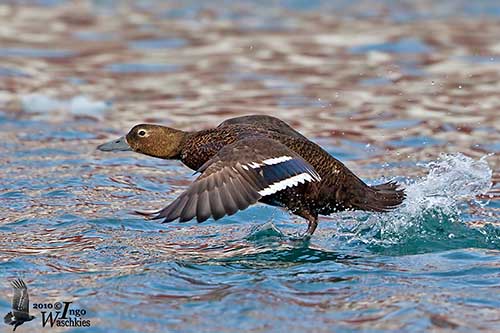
Fr: Eider de Steller
Ang: Steller’s Eider
All: Scheckente
Esp: Éider menor
Ita: Edredone di Steller
Nd: Stellers Eider
Sd: Alförrädare
Photographers:
Otto Plantema
Trips around the world
Ingo Waschkies
Bird Photography
Text by Nicole Bouglouan
Sources:
HANDBOOK OF THE BIRDS OF THE WORLD vol 1 by Josep del Hoyo-Andrew Elliot-Jordi Sargatal - Lynx Edicions - ISBN: 8487334105
GUIDE DES CANARDS, DES OIES ET DES CYGNES – de Steve Madge - Delachaux et Niestlé - ISBN: 2603013769
BirdLife International (BirdLife International)
Wikipedia, the free encyclopaedia
All About Birds (Cornell Lab of Ornithology)
Alaska Department of Fish and Game
European Species Action Plan for Steller’s Eider (Polysticta stelleri)
Compiled by: Stefan Pihl (Wetlands International Seaduck Specialist Group, Denmark)
Eiders... four really strange ducks
Steller’s Eider
Polysticta stelleri
Anseriformes Order – Anatidae Family
INTRODUCTION:
The Steller’s Eider is included in the subfamily Anatinae and in the tribe Mergini, within the large family Anatidae with three other eider species. However, the Steller’s Eider is the sole member of the genus Polysticta, whereas the three other eiders are included in the genus Somateria.
All are diving ducks but the Steller’s Eider is more distinctive and more Anas-like. It could be the link between eiders and other sea ducks.
They occur in Arctic regions and are migratory. The Steller’s Eider is subject to hunting pressure on the moulting grounds, but several other threats involved rapid declines of populations. The species is listed as Vulnerable.
DESCRIPTION OF THE BIRD:
Biometrics:
Length: 43-48 cm
Wingspan: 70-76 cm
Weight: M: 690-1000 g – F: 625-970 g
The adult male in breeding plumage has white head with greenish feathers on lores and nape (forming a short tuft of feathers on the latter). Eye-patch, chin and throat are black, and a black collar joins upper mantle and back.
On the upperparts, sides of mantle and fore part of scapulars are white, whereas tertials and rear part of scapulars show purple markings. On the upperwing, coverts are white, primaries are blackish, and secondaries are iridescent purple-blue with broad white tips, forming a dark wingbar, conspicuous in flight. The tail is black.
On the underparts, breast, upper belly and flanks are buff to orange, with rounded black spot on breast sides. Rest of underparts is dark, mostly blackish-brown on the undertail. The underwing is white with greyish flight feathers.
Bill, legs and feet are blue-grey. The eyes are red-brown.

The male in eclipse plumage resembles female but it is more blackish with greyish-brown head and neck, and narrowly barred brown upper breast.
The female has mainly reddish-brown plumage overall. On the upperparts, feathers have darker centres. The head is paler rufous with pale buff to whitish eyering. The wings are reddish-brown with duller speculum and broad white tips on greater coverts and secondaries. The underwing is similar to male, but with dusky mottling on the leading edge. She has brown eyes.
The juvenile is paler than female and has mottled underparts. The young male has pale buff and whitish feathers on head and breast during the first winter. It gains the full adult plumage by second winter.
RANGE:
The Steller’s Eider breeds in the Arctic coastal plains of N Alaska W to Yamal Peninsula in Siberia, and occasionally to extreme N Norway.
It winters from S Alaska and Bering Sea S to N Japan, NE Atlantic Ocean and Baltic Sea.
HABITAT:
The Steller’s Eider breeds in Arctic open tundra near pools, ponds, lakes and rivers in coastal areas. During winter, it occurs mainly on rocky coasts, but also in bays and estuaries, usually in areas of very shallow water.

CALLS AND SONGS: SOUNDS BY XENO-CANTO
The Steller’s Eider male produces only low growls and short barking calls. The female is often more vocal and gives low barking notes, growling and hoarse whistles, mainly within the winter flocks.
BEHAVIOUR IN THE WILD:
The Steller’s Eider feeds primarily on insect larvae during the breeding season, and also consumes aquatic plants, seeds and flies. This type of food is associated with the freshwater wetlands where it breeds.
Outside the breeding season, it feeds more often in marine habitats where it can find small fish and saltwater invertebrates such as snails, clams, worms and echinoderms from the bottom sediment.
The Steller’s Eider forages alone or in large flocks. It feeds by diving or dabbling in shallow water. While foraging in flocks, several birds often dive and surface in unison.
They are gregarious and can be seen in large flocks all year round, and especially during the moulting period and spring. The moulting areas can be as far as 3000 kilometres from their breeding grounds.

During the displays and like in other duck species, several males (3-7) follow a single female. The courtship displays include numerous head-turns, shakes and rearing out of the water.
However, males often become aggressive towards each other, and some displays in which they raise the head to expose the black chin patch are observed.
They are probably seasonally monogamous. They nest in single pairs or small colonies of about 60 nests, and for better protection, they sometimes nest within Pomarine Skua’s territories.
The Steller’s Eider is migratory and moves up to 3000 kilometres for moulting. Sub-adults leave first, followed by adult males, then non-breeding females and finally breeding females.
They leave the moulting grounds in late April or early May, and continue through May. In E Asia, the migration starts in March and peaks in May.
The Steller’s Eider is less clumsy on land than other eiders. It swims easily with raised tail. It is agile in flight and performs rapid wingbeats. It can take off without running over the water surface.

REPRODUCTION OF THIS SPECIES:
The breeding season occurs between late June and August, as the birds arrive at their breeding grounds in mid-June. They form the pair-bonds during winter. They nest on islands and peninsulas in tundra lakes, ponds and pools, but often near the coasts.
The nest-site is selected by the female while the male protects her and defends the site. The nest is made with grass, and lined with feathers and down during the egg-laying. It is placed on the ground.
The female lays 6-8 olive-brown eggs. The male leaves as soon as the incubation begins performed by the female alone during 25-28 days. At hatching, the chicks have dark/sepia-brown down above and greyer below. The bill is blackish-brown with paler nail. They fledge about 49-50 days after hatching, but they are precocial and can leave the nest within 24 hours, and they can fly about 5-7 weeks after hatching.
This species produces a single brood per season, but a replacement clutch may occur if the first brood is lost.
PROTECTION / THREATS / STATUS:
The Steller’s Eider is threatened by predation by Ravens, Jaegers, large gulls and Snowy Owls, and foxes. On their wintering grounds, they suffer predation by Bald Eagles.
Other threats such as lead poisoning, changes in marine environment with recent changes in Arctic sea ice extent and thickness, contamination by oil spill and hunting, involve declines in populations. A decline rate of 30/49% over 12 years is assumed.
The Steller’s Eider is currently listed as Vulnerable, and it is protected in most parts of its range.